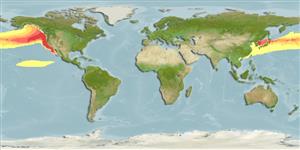Common names from other countries
Environment: milieu / climate zone / depth range / distribution range
Ecologie
Pelagisch. Subtropical; 90°N - 10°N, 180°W - 180°E
Pacific Ocean: Eastward across the Pacific between 34° and 47°N, extending north to 55°N, 145°W, in the Gulf of Alaska (Ref. 1522).
Length at first maturity / Size / Gewicht / Leeftijd
Maturity: Lm ? range ? - ? cm Max length : 310 cm TL mannelijk/geslacht niet bekend; (Ref. 1394); 230 cm TL (female); Maximaal gepubliceerd gewicht: 115.0 kg (Ref. 1394)
Inhabits cold and warm temperate regions. Feeds on squid and lanternfish; but also feeds on a variety of surface and mid-water species (Ref. 1394). Inhabits cold and warm temperate regions. Feeds on squid and lanternfish; but also feeds on a variety of surface and mid-water species (Ref. 1394).
Jefferson, T.A., S. Leatherwood and M.A. Webber. 1993. (Ref. 1394)
Status op de Rode Lijst van het IUCN (Ref. 130435)
Status bij CITES (Ref. 108899)
Not Evaluated
Gebruik door de mens
Visserij: commercieel
FAO - Visserij: landings, soortsprofiel | FishSource | Sea Around Us
Tools
Meer informatie
Leeftijd/Grootte
Groei
Lengte-gewicht parameters
Lengte-lengte parameters
Morfologie
Larven
Abundantie
Internet-bronnen
Estimates based on models
Preferred temperature
(Ref.
115969): 1.2 - 2.5, mean 1.6 (based on 1017 cells).
Kwetsbaarheid
Very high vulnerability (90 of 100).
Prijsklasse
Unknown.
